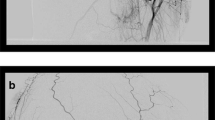Summary
We investigated the haemodynamic dysfunction and secondary thalamic and brainstem atrophy in 24 patients with angiographically proven cerebral arteriovenous malformations (AVM) and no clinical history of cerebral haemorrhage. Cerebral blood flow (CBF) was measured by the method using either stable Xenon or single photon emission computerized tomography (SPECT). Morphological changes in the thalamus and brainstem were evaluated by magnetic resonance imaging (MRI). Two factors are considered to influence hypoperfusion in the ipsilateral cerebral and contralateral cerebellar hemisphere and secondary atrophy of the thalamus and brainstem. One is the size of the nidus and the other is the involvement of the basal ganglia. It is presumed that continuous haemodynamic stress over a long period of time may cause irreversible histological changes in areas remote from the lesion, especially in the AVM which demonstrates involvement of the basal ganglia or a large nidus.
Similar content being viewed by others
References
Barnett GH, Little JR, Ebrahim ZY, Jones SC, Friel HT (1987) Cerebral circulation during arteriovenous malformation operation. Neurosurgery 20: 836–842
Homan RW, Devous MD, Stokely EM, Bonte FJ (1986) Quantification of intracerebral steal in patients with arteriovenous malformation. Arch Neurol 43: 779–785
Iizuka H, Sakatani K, Young W (1990) Neural damage in the rat thalamus after cortical infarcts. Stroke 21: 790–794
Kempinsky WH (1966) Vascular and neural factors in diaschisis with focal cerebral ischemia. Res Publ Assoc Nerv Ment Dis 41: 92–115
Kuhl DE, Phelps ME, Kowell AP, Metter EJ, Selin C, Winter J (1980) Effects of stroke on local cerebral metabolism and perfusion: mapping by emission computed tomography of 18 FDG and 13 NH 3. Ann Neurol 8: 47–60
Kuriyama Y, Sawada T, Karasawa J, Kikuchi H (1984) The mapping image of local cerebral blood flow by use of stable Xenon and CT. Proceeding of the 4th annual meeting of the Japanese Congress of Neurological Surgeons 4: 154–165
Marks MP, Donahue JO, Fabricant JI, Frankel KA, Phillips MH, Delapaz RL, Enzmann DR (1988) Cerebral blood flow evaluation of arteriovenous malformations with stable Xenon CT. AJNR 9: 1169–1175
Menon D, Weir B (1979) Evaluation of cerebral blood flow in arteriovenous malformations by the Xenon 133 inhalation method. Can J Neurol Sci 6: 411–416
Meyer JS, Naritomi H, Sakai F, Ishihara N, Grant P (1979) Regional cerebral flow, diaschisis, and steal after stroke. Neurol Res 1: 101–119
Nornes H, Grip A (1980) Haemodynamic aspects of cerebral arteriovenous malformations. J Neurosurg 53: 456–464
Okabe T, Meyer JS, Okayasu H, Harper R, Rose J, Grossman RG, Centeno R, Tachibana H, Lee YY (1983) Xenon-enhanced CT CBF measurements in cerebral AVM's before and after excision. J Neurosurg 59: 21–31
Pappata S, Mazoyer B, Dinh T, Cambon H, Levasseur M, Baron JC (1990) Effects of capsular or thalamic stroke on metabolism in the cortex and cerebellum: a positron tomography study. Stroke 21: 519–524
Pertuiset B, Ancri D, Clergue F (1982) Preoperative evaluation of haemodynamic factors in cerebral arteriovenous malformations for selection of a radical surgery tactic with special reference to vascular autoregulation disorders. Neurol Res 4: 209–233
Shenkin HA, Spitz EB, Grant FC, Kety SS (1948) Physiologic studies of arteriovenous anomalies of the brain. J Neurosurg 5: 165–172
Tamaki N, Lin T, Asada M, Fujita K, Tominaga S, Kimura M, Ehara K, Matsumoto S (1990) Modulation of blood flow following excision of a high-flow cerebral arteriovenous malformation. Case report. J Neurosurg 72: 509–512
Tamura A, Tahira Y, Nagashima H, Kirino T, Gotoh O, Hojo S, Sano Kenji (1991) Thalamic atrophy following cerebral infarction in the territory of the middle cerebral artery. Stroke 22: 615–618
Tarr RW, Johnson DW, Rutigliano M, Hecht ST, Pentheny S, Jungreis CA, Horton JA, Yonas H (1990) Use of acetazolamidechallenge Xenon CT in the assessment of cerebral blood flow dynamics in patients with arteriovenous malformations. AJNR 11: 441–448
Wise R, Gibbs J, Frackowiak R, Marshall J, Jones T (1986) No evidence for transhemispheric diaschisis after human cerebral infarction. Stroke 17: 853–861
Author information
Authors and Affiliations
Rights and permissions
About this article
Cite this article
Tanaka, K., Yonekawa, Y., Kaku, Y. et al. Arteriovenous malformation and diaschisis. Acta neurochir 120, 26–32 (1993). https://doi.org/10.1007/BF02001465
Issue Date:
DOI: https://doi.org/10.1007/BF02001465




